Britannia Airways
Britannia Airways was a charter airline based in the UK. It was founded in 1961 as Euravia and became the world's largest holiday airline. Britannia's main bases were at London Gatwick, London Stansted, London Luton, Cardiff, Bristol, East Midlands, Birmingham, Manchester, Newcastle, Leeds Bradford, Liverpool, Edinburgh and Glasgow. It had its headquarters at Britannia House in Luton.[1]
 | |||||||
| |||||||
| Founded | 1 December 1961 (as Euravia) | ||||||
|---|---|---|---|---|---|---|---|
| Ceased operations | 1 November 2005 (rebranded as Thomsonfly) | ||||||
| Operating bases | |||||||
| Fleet size | 47 | ||||||
| Destinations | 42 | ||||||
| Parent company | TUI | ||||||
| Headquarters | Luton Airport, England | ||||||
Britannia was originally a charter operator for Universal Sky Tours and later for Thomson holidays where it became the in-house airline with a fleet of Boeing jet aircraft.
In 2000, Thomson Travel Group, and thereby Britannia Airways, were acquired by TUI Group of Germany. As part of a wider reorganisation of TUI's UK operations in September 2004, Britannia was rebranded as Thomsonfly.
History
Origins


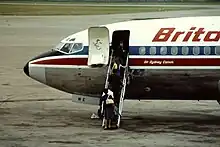
The airline was established as Euravia (London) by British businessman T.E.D. Langton and aviation consultant J.E.D. Williams on 1 December 1961.[2] It was founded at a time of considerable turmoil for the independent sector of the British air operators industry, during the early 1960s, several firms suffered from severe financial hardship and were even driven into bankruptcy.[3] Upon deciding to launch operations, the company quickly obtained the necessary licences from the Air Transport Licensing Board, airworthiness certificates for its aircraft from the Air Registration Board, and an Air Operator's Certificate from the Ministry of Aviation.[3] These applications were not without some difficulty as Euravia had the distinction of being refused more licences than any other two airlines put together; this was due to the fact that the firm placed a larger number of applications than any British airline, except for British United Airways (BUA).[4][5]
On 1 April 1962, Euravia established its initial operating base at Luton Airport; on 13 April, the airline's first aircraft, a Lockheed Constellation, was delivered for certification and training.[6] Early on, Euravia benefitted from its close association with inclusive tour holiday company Universal Sky Tours.[7][8] On 5 May 1962, Euravia commenced flight operations, using an initial batch of three Constellations to perform flights on behalf of Universal Sky Tours.[9] Within ten days, the operation was reportedly breaking-even; by a month later, the firm's initial fleet was operating at its maximum planned utilisation rate.[10]
On 5 October of that same year, a rival charter airline Skyways, one of Britain's foremost independent airlines during the 1950s and early 1960s, was taken over by Euravia and integrated into its operations.[10] The Skyways takeover did not include Skyways Coach-Air, a Skyways associate, established in the early 1950s by Eric Rylands to operate low-fare coach-air services between London and several European capital cities. Following Euravia's acquisition of Skyways, Skyways Coach-Air remained independent until its successor Skyways International was taken over by Dan-Air in 1972.[11]
By 15 June 1963, Euravia was operating a mixed fleet of eight Constellations and four Avro Yorks.[12] Euravia also took on Skyways Pan Am engine contract at London Heathrow using ex-Skyways Yorks; under this arrangement, one of these aircraft was on permanent standby at Heathrow ready to fly a spare jet engine to rescue any PanAm Boeing 707 jetliner that encountered engine problems. These rescue flights were flown as far afield as Singapore and Hong Kong. The other Yorks were used for ad hoc freighting until 1965 when the last aircraft G-AGNV was flown from Luton to Staverton, Gloucester to be an exhibit at the now defunct Skyfame museum. Upon retirement, this aircraft was preserved and placed on display at the RAF museum, RAF Cosford.[13]
Rebranding
On 16 August 1964, the airline was rebranded, becoming Britannia Airways;[8] this name was adopted to coincide with re-equipping with ex-British Overseas Airways Corporation (BOAC) Bristol Britannia turboprop airliners to replace the Constellations.[2] The type would not be used for long however; during December 1970, the last remaining Britannia 102 was withdrawn from service, consequently, the airline became an all-jet operator at this point. During the late 1960s, Britannia became the first charter airline to offer assigned seating, as well as hot in-flight meals.[5][8]
During the mid-1960s, Britannia had attracted the interest of the newspaper business magnate Lord Thomson, who sought a good prospect with which to diversify his business stakes; Thomson also approved of the company's activities being beneficial to the general public.[2] As a result of this interest, during 1965, Britannia became part of Thomson, itself part of the Canadian-owned International Thomson Organisation. This acquisition was beneficial to the company's prospects, including financing the acquisition of a new generation of jet-powered airliners to enable Britannia's rapid transition into the jet age.[2]

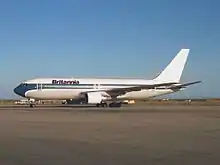
%252C_Britannia_Airways_JP6291725.jpg.webp)
During 1968, Britannia commenced a re-equipment effort involving the then-new Boeing 737-200 jetliner; it had the distinction of being the first European airline to operate the type.[8] The purchase of the brand new and relatively unproved 737 was seen as a major breach of traditional practice; historically, charter airliners procured secondhand aircraft from their larger scheduled airlines. In addition, the large 'flag carriers' were comparatively wary of the value of jet-powered aircraft, normally opting for comfort and high-quality passenger conditions over speeds.[14] This unconventional purchase was also politically controversial; Sir George Edwards, the chairman of the British Aircraft Corporation (BAC), had expected Britannia to order the rival BAC One-Eleven and lobbied government officials to convince the airline to procure the British airliner instead. These pressure tactics ultimately proved to be unsuccessful; by 1975, Britannia was operating a fleet of 13 Boeing 737s.[15]
By 1972, the airline had become the largest of the British independent charter airlines.[2] Prior to the mid-1970s, Britannia, much like other British charter airlines of the era, had concentrated upon low-cost flights to Spain and the use of provincial airports (other than its Luton base) to provide its services.[16] However, the company held ambitions to expand beyond this. During 1988, Britannia's 767s were used to commence regular charter flights between Britain and Australia, as well as to New Zealand the following year. Between 1968 and 1984, Britannia carried nearly 42 million passengers, while the company's fleet grew to include twenty-nine Boeing 737s and a pair of 767s.[8]
Britannia also became the first European airline to fly the Boeing 767, which was added to its fleet in the 1980s; the 767 was the first widebodied aircraft to enter service in the company's fleet and enabled Britannia to become the first British holiday airline to offer passengers free in-flight audio and video entertainment.[8]
During August 1988, Britannia's immediate parent company, the Thomson Travel Group, purchased Horizon Travel and its airline, Orion Airways, which was then integrated into Britannia.[8]
Later service
During the 1990s, Britannia also began to operate services for Skytours and Portland Direct, themselves also part of the Thomson Group. During this time, Britannia heavily modernised its fleet and expanded its route network to holiday destinations in Asia, Canada, South Africa, and the United States.[8] During 1997, 34 per cent of Britannia's flights were flown to long-haul destinations. By the summer of 1998, Britannia's operations, which were by then centered around Germany, Scandinavia, and the United Kingdom, operated a mixed fleet of three Airbus A320s, a single Boeing 737-800, 24 757s and 13 767s.[8]
Several efforts were made at European expansion during this time. During 1997, Britannia formed a wholly owned subsidiary, Britannia GmbH, based in Germany to operate long and short-haul flights from airports in Germany, Switzerland and Austria for German tour operators, flying several 767-300s.[8][17] On 3 November 1997, the subsidiary's inaugural flight was flown, flying between Berlin and the Dominican Republic. At one point, Britannia Airways GmbH employed roughly 200 people and operated 3 Boeing 767-300s;[8] however, this division was relatively unsuccessful and ultimately closed down during March 2001. During early 1998, the Thomson Travel Group also acquired the Scandinavian holiday operation, Fritidsresor Group, along with its airline Blue Scandinavia, which was later renamed Britannia Nordic (since rebranded as TUI fly Nordic).[17]
In addition, it was during this decade that Britannia launched several public image and service quality initiatives, such as the flying with confidence course and closer customer service coordination within Thomson.[18] During the early 1990s, the airline launched its in-flight Royal Service brand to increase the profile of the company's high-end services, somewhat akin to the premium service levels available on scheduled airlines.[19] It was succeeded by a newer brand, 360, during the late 1990s; this service was billed as being less old-fashioned and possessed greater personality.[20]
During 2000, Thomson Travel Group, and thereby Britannia Airways, were acquired by TUI Group of Germany.[21] As part of a wider reorganisation of TUI's UK operations in September 2004, it was announced that Britannia would be rebranded as Thomsonfly.[22]
Destinations
As of January 1995, Britannia Airways operated services to the following international scheduled destinations:
- Europe
- Middle East
only for Full stop over
- North & South America
- Africa
- Asia
- Oceania
Fleet
The Britannia Airways fleet consisted of the following aircraft:[23][24]
| Aircraft | Total | Capacity | Notes |
|---|---|---|---|
| Boeing 737-200 | 45 | 130 | Last 737-200 "'G-BGYJ" left the fleet 30 March 1994. |
| Boeing 737-300 | 7 | 148 | Last 737-300 "G-BLKB" left the fleet 11 April 1993. |
| Boeing 737-800 | 2 | 189 | Last 737-800 "PH-ABE" left the fleet 9 January 2002. Transferred to sister company "Britannia Airways Sweden" as SE-DZM. |
| Boeing 757-200 | 28 | 235 | Most aircraft transferred to Thomsonfly. G-BYAG written off after crash landing at Girona airport |
| Boeing 767-200ER | 13 | 290 | Last aircraft "G-BRIG" transferred to Thomsonfly 1 November 2005. |
| Boeing 767-300ER | 12 | 283/326 | Last aircraft "G-OBYD" transferred to Thomsonfly 31 October 2005. |
| Airbus A320-200 | 6 | 140-170 | Leased from TransAer between 1998 and 2000. |
| Lockheed L-1011 TRIstar | 1 | 400 | Leased from Air Atlanta Icelandic between July and December 1998 |
| Airbus A300 | 3 | 210-250 | Inherited from Orion Airways. Never flew under the Britannia branding. |
The Airline also operated Bristol Britannia aircraft and Boeing 707s.
 A Britannia Airways 737-200
A Britannia Airways 737-200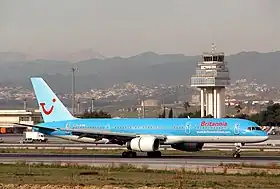 A Britannia 757-200 in the pre-rebrand livery.
A Britannia 757-200 in the pre-rebrand livery. "G-BYAY" on climb out.
"G-BYAY" on climb out.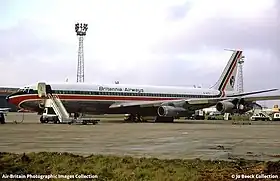 A Britannia Boeing 707
A Britannia Boeing 707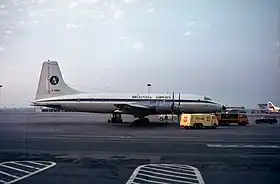 A Britannia 'Bristol Britannia' at Munich
A Britannia 'Bristol Britannia' at Munich A Britannia Boeing 767 at Birmingham, Uk.
A Britannia Boeing 767 at Birmingham, Uk.
Competitors
At the time of rebranding, Britannia was the largest charter airline in the United Kingdom, its position of market dominance being owed to the growth of Thomson Holidays. Initially its main competitor was British Airtours. The 1980s saw the growth of Monarch Airlines as a credible competitor. In the 1990s Air 2000, Airtours International, First Choice Airways and Flying Colours Airlines grew as competitors. Its main competitor at the time of rebranding was Thomas Cook Airlines.
Incidents and accidents
Britannia Airways suffered two accidents whilst operating under that name (1961–2005):[25]
- On 1 September 1966, Britannia Airways Flight 105, a Bristol 175 Britannia, crashed into high ground on the approach to landing at Ljubljana, Slovenia due to pilot error after a flight from Luton, England. Of the 117 onboard 98 died.[26][27]
- On 14 September 1999, Britannia Airways Flight 226A, a Boeing 757-204, crashed on its second attempt at landing in heavy rain and poor weather conditions. Of the 236 passengers and 9 crew on board, two were seriously injured and 41 sustained minor injuries. One of the passengers who had apparently sustained only minor injuries died five days later of suspected internal injuries. The flight was an international charter between Cardiff, Wales and Girona Airport, Spain.[28]
See also
- Thomsonfly
- Thomson Airways
- TUI fly Nordic (formerly Britannia Airways AB)
- TUI Airlines
- List of defunct airlines of the United Kingdom
References
Citations
- World Airline Directory Flight International 28 March 2000
- Segreto, Manera and Pohl 2009, p. 23.
- Williams 1963, p. 187.
- Williams 1963, p. 188.
- Ruled Britannia Airliner World January 2020 pages 26-32
- Williams 1963, pp. 187–189.
- Williams 1963, pp. 187–188.
- "Britannia Airways: Holiday Carrier to the World." Boeing, Retrieved: 28 October 2017.
- Williams 1963, pp. 188–189.
- Williams 1963, p. 189.
- Simons, G.M. The Spirit of Dan-Air. GMS Enterprises, Peterborough, 1993. pp. 77/8.
- Williams 1963, p. 190.
- "Avro York C1." RAF Museum, Retrieved: 28 October 2017.
- Segreto, Manera and Pohl 2009, pp. 23, 25, 27.
- Segreto, Manera and Pohl 2009, pp. 21, 23.
- Segreto, Manera and Pohl 2009, pp. 23–24.
- Ormes 2002, p. 92.
- Ormes 2002, pp. 90, 92, 94.
- Ormes 2002, pp. 88–89.
- Ormes 2002, pp. 89–90.
- "Goodbye Thomson, hello TUI – how Germany beat Britain in the battle of the sunlounge". The Daily Telegraph. London. 18 October 2017. Retrieved 11 March 2019.
- "Axe falls as Britannia parent TUI restructures". FlightGlobal. 5 October 2004. Retrieved 22 September 2019.
- "Historical fleet | Britannia". caa.co.uk.
- "Britannia Airways Fleet | Airfleets aviation". airfleets.net. Retrieved 22 February 2023.
- "Britannia Airways incidents and accidents." aviation-safety.net, Retrieved: 28 October 2017.
- "Britannia Airways Flight 105." aviation-safety.net, Retrieved: 28 October 2017.
- "Altimeter Setting in Doubt at Ljubljana – Jugoslav report criticises crew and airline." Flight International, 12 September 1968. p. 397. (PDF file), continued, p. 398.
- Marston, Paul. "Pilot 'froze' before holiday jet crashed." The Daily Telegraph, 3 September 2004.
Bibliography
- Cuthbert, Geoffrey: Flying to the Sun: Quarter Century of Britannia Airways; London, UK: Hodder & Stoughton 1987, ISBN 978-0-340-41020-2.
- Merton-Jones, A.C. : British Independent Airlines Since 1946; Volume One; Liverpool, UK: Merseyside Aviation Society & LAAS 1976 ISBN 978-0-902420-07-6.
- Ormes, Ian. A Chartered Success. Granta Editions, 2002. ISBN 1-85757-078-2.
- Segreto, Luciano., Carles Manera and Manfred Pohl. "Europe At the Seaside: The Economic History of Mass Tourism in the Mediterranean." Berghahn Books, 2009. ISBN 1-84545-911-3.
- Simons, Graham M. (1993). The Spirit of Dan-Air. Peterborough, UK: GMS Enterprises. ISBN 978-1-870384-20-9..
- ————————— (2020). Britannia Airways: The World's Largest Holiday Airline. Barnsley, South Yorkshire: Air World Books. ISBN 9781526758781.
- Williams, J.E.D. "Starting a New British Airline." Flight International, 7 February 1963. pp. 187–190.
External links
- Britannia Airways (Archive)
- Britannia Airways (Archive)
- Fleet
- Photos of Britannia Airways aircraft